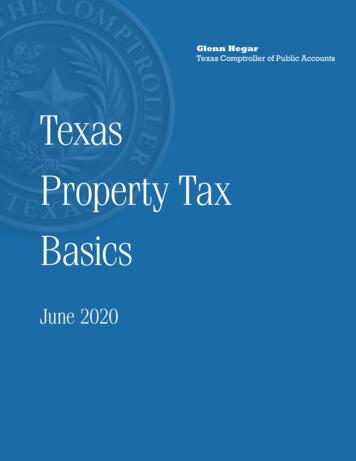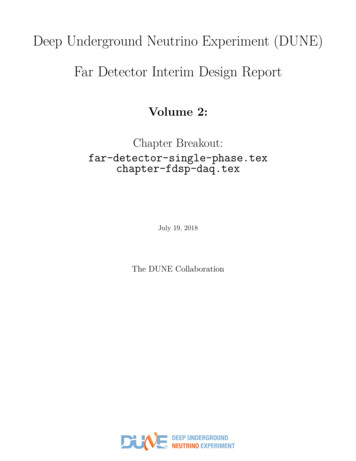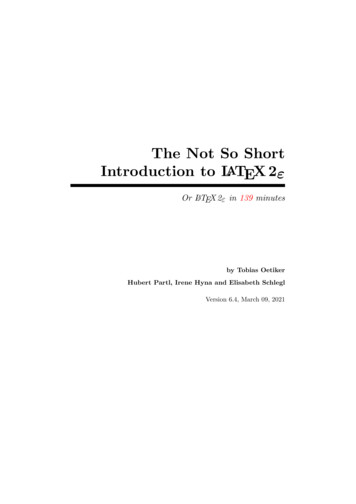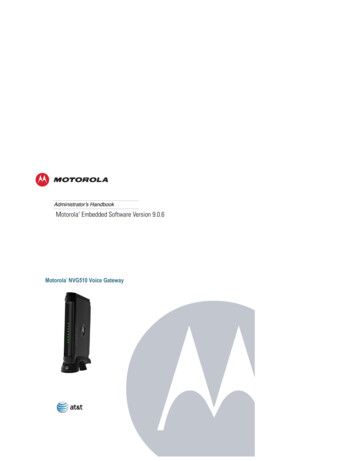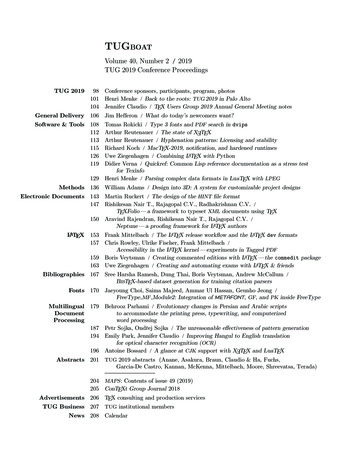
Transcription
TUGBOATVolume 40, Number 2 / 2019TUG 2019 Conference Proceedings98 Conference sponsors, participants, program, photos101 Henri Menke / Back to the roots: TUG 2019 in Palo Alto104 Jennifer Claudio / TEX Users Group 2019 Annual General Meeting notesGeneral Delivery106Software & Tools108112113115126119Methods136Electronic Documents143147LATEXJim Hefferon/What do today’s newcomers want?Tomas Rokicki / Type 3 fonts and PDF search in dvipsArthur Reutenauer / The state of X TEXArthur Reutenauer / Hyphenation patterns: Licensing and stabilityRichard Koch / MacTEX-2019, notification, and hardened runtimesUwe Ziegenhagen / Combining LATEX with PythonDidier Verna / Quickref: Common Lisp reference documentation as a stress testfor Texinfo129 Henri Menke / Parsing complex data formats in LuaTEX with LPEGETUG 2019William Adams/Design into 3D: A system for customizable project designsMartin Ruckert The design of the HINT file formatRishikesan Nair T., Rajagopal C.V., Radhakrishnan C.V. /TEXFolio — a framework to typeset XML documents using TEX150 Aravind Rajendran, Rishikesan Nair T., Rajagopal C.V. /Neptune — a proofing framework for LATEX authors/153 Frank Mittelbach / The LATEX release workflow and the LATEX dev formats157 Chris Rowley, Ulrike Fischer, Frank Mittelbach /Accessibility in the LATEX kernel — experiments in Tagged PDF159 Boris Veytsman / Creating commented editions with LATEX — the commedit package163 Uwe Ziegenhagen / Creating and automating exams with LATEX & ntProcessing179Sree Harsha Ramesh, Dung Thai, Boris Veytsman, Andrew McCallum /BIBTEX-based dataset generation for training citation parsersJaeyoung Choi, Saima Majeed, Ammar Ul Hassan, Geunho Jeong /FreeType MF Module2: Integration of METAFONT, GF, and PK inside FreeTypeBehrooz Parhami / Evolutionary changes in Persian and Arabic scriptsto accommodate the printing press, typewriting, and computerizedword processing187 Petr Sojka, Ondřej Sojka / The unreasonable effectiveness of pattern generation194 Emily Park, Jennifer Claudio / Improving Hangul to English translationfor optical character recognition (OCR)196 Antoine Bossard / A glance at CJK support with X TEX and LuaTEXEAbstracts201TUG 2019 abstracts (Anane, Asakura, Braun, Claudio & Ha, Fuchs,Garcia-De Castro, Kannan, McKenna, Mittelbach, Moore, Shreevatsa, Terada)204205Advertisements206MAPS : Contents of issue 49 (2019)ConTEXt Group Journal 2018TEX consulting and production servicesTUG Business207TUG institutional membersNews208Calendar
TEX Users GroupBoard of DirectorsTUGboat (ISSN 0896-3207) is published by theTEX Users Group. Web: tug.org/TUGboat.Donald Knuth, Ur Wizard of TEX-arcana †Boris Veytsman, President Arthur Reutenauer , Vice PresidentKarl Berry , TreasurerKlaus Höppner , SecretaryBarbara BeetonJohannes BraamsKaja ChristiansenJim HefferonTaco HoekwaterFrank MittelbachRoss MooreCheryl PonchinNorbert PreiningWill RobertsonHerbert VoßRaymond Goucher, Founding Executive Director †Hermann Zapf (1918–2015), Wizard of FontsIndividual memberships2019 dues for individual members are as follows:Trial rate for new members: 20.Regular members: 105.Special rate: 75.The special rate is available to students, seniors, andcitizens of countries with modest economies, as detailed on our web site. Members may also choose toreceive TUGboat and other benefits electronically,at a discount. All membership options are describedat tug.org/join.html.Membership in the TEX Users Group is for thecalendar year, and includes all issues of TUGboat forthe year in which membership begins or is renewed,as well as software distributions and other benefits.Individual membership carries with it such rightsand responsibilities as voting in TUG elections. Allthe details are on the TUG web site.Journal subscriptionsTUGboat subscriptions (non-voting) are available toorganizations and others wishing to receive TUGboat in a name other than that of an individual.The subscription rate for 2019 is 110.Institutional membershipsInstitutional membership is primarily a means ofshowing continuing interest in and support for TEXand TUG. It also provides a discounted membershiprate, site-wide electronic access, and other benefits.For further information, see tug.org/instmem.htmlor contact the TUG office.TrademarksMany trademarked names appear in the pages ofTUGboat. If there is any question about whethera name is or is not a trademark, prudence dictatesthat it should be treated as if it is. member†of executive committeehonorarySee tug.org/board.html for a roster of all past andpresent board members, and other official positions.AddressesElectronic MailTEX Users GroupP. O. Box 2311Portland, OR 97208-2311U.S.A.General correspondence,membership, subscriptions:office@tug.orgTelephone 1 503 223-9994Fax 1 815 301-3568Webtug.orgtug.org/TUGboatSubmissions to TUGboat,letters to the Editor:TUGboat@tug.orgTechnical support forTEX users:support@tug.orgContact theBoard of Directors:board@tug.orgCopyright c 2019 TEX Users Group.Copyright to individual articles within this publicationremains with their authors, so the articles may notbe reproduced, distributed or translated without theauthors’ permission.For the editorial and other material not ascribed to aparticular author, permission is granted to make anddistribute verbatim copies without royalty, in any medium,provided the copyright notice and this permission noticeare preserved.[printing date: September 2019]Printed in U.S.A.Permission is also granted to make, copy and distributetranslations of such editorial material into anotherlanguage, except that the TEX Users Group must approvetranslations of this permission notice itself. Lacking suchapproval, the original English permission notice mustbe included.
2019 Conference ProceedingsTEX Users GroupFortieth annual TUG meetingPalo Alto, California, USAAugust 9–11, 2019COMMUNICATIONS OF THE TEX USERS GROUPTUGBOAT EDITORBARBARA BEETONPROCEEDINGS EDITOR KARL BERRYVOLUME 40, NUMBER 2, 2019PORTLAND, OREGON, U.S.A.
98TUGboat, Volume 40 (2019), No. 2TUG 2019 — Palo Alto, California, USAhttps://tug.org/2019tug2019@tug.orgSheraton Palo Alto Hotel625 El Camino RealPalo Alto, CA 94301SponsorsDANTE e.V.TEX Users GroupAdobe Google Overleaf Pearson STM Document Engineering Pvt Ltdwith notable assistance from individual contributors. Thanks to all!Special guestDonald E. KnuthConference committeeKarl BerryJennifer ClaudioRobin LaaksoBoris VeytsmanParticipantsAmine Anane, Montreal, CanadaWilliam Adams, Mechanicsburg, PAPavneet Arora, Bolton, ONTakuto Asakura, National Instituteof Informatics, JapanBrian Bartling, AMSNelson Beebe, University of UtahBarbara Beeton, TEX Users GroupAntoine Bossard, Kanagawa UniversityErik Braun, CTANAleksandar Bradic, SupplyframeKevin Edward Cain, Institute for the Studyof Graphical HeritageJaeyoung Choi, Soongsil UniversityDennis ClaudioJennifer Claudio, Oak Grove High SchoolAlan Davis, Oakland, CASusan DeMeritt, IDA/CCR, La Jolla, CADavid FuchsShawn Gaither, AdobeFederico Garcia-De Castro, Alia Musica PittsburghPeter Giunta, Somerville, MAPaul Gill, Los Gatos, CASteve Grathwohl, Chapel Hill, NCSally Ha, Oak Grove High SchoolMatthew Hardy, AdobeJim Hefferon, St Michael’s CollegeJoe Hogg, Los Angeles, CAChris Jimenez, Stetson UniversityDouglas Johnson, Savannah, GAShakthi Kannan, Chennai, IndiaPatrick Kelley, GoogleRohit Khare, GoogleDonald Knuth, Stanford UniversityRichard Koch, University of OregonYusuke Kuroki, Yokohama, JapanRobin Laakso, TEX Users GroupDoug McKenna, Mathemaesthetics, Inc.Henri Menke, University of OtagoFrank Mittelbach, LATEX3 ProjectMostafa Mortezaie, DeVry UniversityAndrea O’Riordan, UCLABehrooz Parhami, UC Santa BarbaraEmily Park, San Jose, CAGanesh Pimpale, San Jose, CACheryl Ponchin, IDA/CCR, Princeton, NJArthur Reutenauer, Uppsala, SERishi T, STM Document Engineering Pvt LtdTomas Rokicki, Palo Alto, CAChris Rowley, LATEX3 ProjectMartin Ruckert, Hochschule MünchenEdgaras Šakuras, VTEXHerbert Schulz, Naperville, ILSenthil, San Ramon, CAMichael Sharpe, UCSDKeiichiro Shikano, TokyoShreevatsa R, Sunnyvale, CAOndřej Sojka, CS TUGPetr Sojka, Masaryk University, Faculty of Informaticsand CS TUGNate Stemen, OverleafPaulo Ney de Souza, BooksInBytesLinas Stonys, VTEXYusuke Terada, Tokyo Educational InstituteRebecca Turner, GoogleBrian Tracy, Brown UniversityDidier Verna, EPITABoris Veytsman, Chan Zuckerberg Initiativeand George Mason UniversityPaul Vojta, UC BerkeleyJoseph Weening, San Diego, CAAlan Wetmore, Silver Spring, MDUwe Ziegenhagen, Cologne, GermanyJiřı́ Zlatuška, Masaryk University, Faculty of Informatics
TUG 2019 program8:55 am9:00 am9:30 am10:00 am10:30 am10:45 am11:15 am11:45 am12:15 pm1:15 pm1:30 pm2:30 pm3:00 pm3:15 pm3:45 pmannouncementsPetr Sojka, Ondřej SojkaArthur ReutenauerDavid FuchsbreakTomas Rokicki, Palo Alto, CAMartin Ruckert, Hochschule MuenchenDoug McKenna, Mathemaesthetics, Inc.lunchgroup photoJennifer Claudio, Sally Ha, Oak Grove H.S.William Adams, Mechanicsburg, PAbreakBoris Veytsman, Sch. Systems Biology, GMUBehrooz Parhami, UC Santa Barbara4:15 pm Amine Anane, Montréal, QC4:45 pm Takuto Asakura, National Institute ofInformatics, Japan5:15 pm Herb Schulz, Naperville, IL6:30 pm banquetSundayAugust 118:55 am announcements9:00 am Antoine Bossard, Kanagawa University9:30 am Jaeyoung Choi, Saima Majeed, AmmarUl Hassan, Geunho Jeon, Soongsil Univ.10:00 am Jennifer Claudio, Emily Park, Oak Grove H.S.10:30 am break10:45 am Rishikesan Nair T*, Rajagopal C.V.,Radhakrishnan C.V.11:15 am Sree Harsha Ramesh, Dung Thai, BorisVeytsman*, Andrew McCallum, UMassAmherst, (*) Chan Zuckerberg Initiative11:45 am Didier Verna, EPITA12:15 pm lunch1:30 pm Uwe Ziegenhagen2:00 pm Yusuke Terada, Tokyo Educational Institute2:30 pm Chris Rowley*, Ulrike Fischer, LATEX3 Project3:00 pm break3:15pm Ross Moore, Macquarie Univ. 3:45 pm endWelcomeCurrent state of CTANThe state of X TEXThe LATEX “dev” formatTaming UTF-8 in pdfTEXCombining LATEX with PythonParsing complex data formats in LuaTEX with LPEGBig changes in MacTEX, and why users should never noticeA few words about OverleafNeptune — a proofing framework for LATEX authorsRain Rain Go Away: Some thoughts on rain protection, and its usesWhat I learned from trying to read the TEX programTEX in Schools? Just Say Yes, given that . . .X TEX Book TemplateWhat do today’s newcomers want?The unreasonable effectiveness of pattern generationHyphenation patterns in TEX Live and beyondWhat six orders of magnitude of space-time buys youSearchable PDFs with Type 3 bitmap fontsThe design of the HINT file formatAn interactive iOS math book using a new TEX interpreter libraryA brief exploration of artistic elements in letteringDesign into 3D: A system for customizable project designsCreating commented editions with TEXEvolutionary changes in Persian and Arabic scripts to accommodatethe printing press, typewriting, and computerized word processingArabic typesetting using a Metafont-based dynamic fontA TEX-oriented research topic: Synthetic analysis on mathematicalexpressions and natural languageOptional workshop: TeXShop tips & tricksSheraton Palo AltoE2:30 pm3:00 pm3:15 pm3:45 pm4:15 pm4:45 pm5:15 pmregistrationBoris Veytsman, TEX Users GroupErik Braun, CTANArthur Reutenauer, Uppsala, SwedenFrank Mittelbach, LATEX3 ProjectbreakFrank MittelbachUwe Ziegenhagen, Cologne, GermanyHenri Menke, University of OtagolunchDick Koch, University of OregonNate Stemen, Overleaf, Inc.Aravind Rajendran, Rishikesan Nair T*,Rajagopal C.V., STM Doc. Eng. Pvt LtdPavneet Arora, Bolton, ONbreakShreevatsa R, Sunnyvale, CAPetr Sojka, Masaryk University & CS TUGShakthi Kannan, Chennai, IndiaJim Hefferon, St Michael’s CollegeTUG Annual General MeetingESaturdayAugust 108:15 am8:55 am9:00 am9:30 am10:00 am10:30 am10:45 am11:15 am11:45 am12:15 pm1:30 pm1:45 pm2:00 pmEFridayAugust 9(* presenter)A glance at CJK support with X TEX and LuaTEXFreeType MF Module 2: Integration of METAFONT and TEX-orientedbitmap fonts inside FreeTypeImproving Hangul to English translationTEXFolio — a framework to typeset XML documents using TEXBibTEX-based dataset generation for training citation parsersQuickref: A stress test for TexinfoCreating and automating exams with LATEX & friendsConstruction of a digital exam grading system using TEXAccessibility in the LATEX kernel — experiments in tagged PDFLATEX 508 — creating accessible PDFs
100TUGboat, Volume 40 (2019), No. 2Pictures from the Annual MeetingAWHere are some snapshots of the TUG 2019 meeting.Credits to Jennifer Claudio, Rishikesan Nair T, andAlan Wetmore. Thank you. You can also see a tensecond movie panorama of the group at:tug.org/tug2019/photos/group-movie.movAWFrank Mittelbach, Michael Sharpe,Steve GrathwohlAWDon Knuth demonstrates the organ at hishome to Nelson BeebeRTAWDennis Claudio, Boris Veytsman,Barbara BeetonYusuke Terada, Jennifer ClaudioAWAWMartin Ruckert,Doug McKennaDon Knuth examining his gift,with Chris Rowley at thebanquetAWOndřej Sojka, Petr SojkaJCJim Hefferon,Rishikesan Nair TThe whole group. Everybody smile!
TUGboat, Volume 40 (2019), No. 2Back to the roots: TUG 2019 in Palo AltoHenri MenkeThursday, August 8This year’s TUG meeting stood under a very special sign. TEX returned to its birthplace, StanfordUniversity in Palo Alto, California, USA. And notonly did it return to its cradle, but also its inventorwould be there, none other than the great Donald E.Knuth (DEK) himself. It was a great honor to havesuch a very special guest at the meeting.The evening before the meeting, there was areception and registration at the conference site, theSheraton Hotel. Many participants showed up andDEK was also there to personally welcome everyone.Friday, August 9On the morning of the first day our current president,Boris Veytsman, officially opened the conference.The first speaker to kick off the program was ErikBraun from the CTAN team to talk about goals anddifficulties CTAN is facing. A notable quote fromthe talk is that “the Comprehensive TEX ArchiveNetwork is neither comprehensive nor an archive”.However, the team wants to change that in the futuretogether with some new web design.Next up Arthur Reutenauer, a current maintainer of XETEX, enlightened us about the past,present, and future state of XETEX. As it currentlyseems, XETEX might go into maintenance mode, because the original author Jonathan Kew has movedon to other projects and major contributor KhaledHosny, who ported XETEX from AAT to HarfBuzz,has focused his attention on LuaTEX, leaving no competent developer. With recent progress in LuaTEXand its likely adoption of HarfBuzz, the main usecases for XETEX will be covered, making it kind ofobsolete. Right now, Arthur tries to isolate XETEXspecific code from the engine, to maybe contributethose patches to LuaTEX.Before the morning break, Frank Mittelbachintroduced us to the LATEX “dev” format. The “dev”format is a preview of the next official release ofthe LATEX format and is shipped with TEX Live forinterested users to try out. The LATEX team hopes toattract more beta testers this way, so that problems,especially regressions, can be detected before officialreleases, reducing the number of required hotfixes.After the break, Frank Mittelbach continuedwith a second talk about UTF-8 in LATEX. A few yearsago the “Unicode revolution” was completed and almost everything is formatted in UTF-8 nowadays.Unfortunately, the old 8-bit TEX engines do not sup-101port UTF-8 natively, so the well-known inputenc wasintroduced, which knows about the “magic” multibyte sequences of UTF-8 and does the right thingby converting the characters into the LATEX internalcharacter representation (LICR). This technique hasbeen integrated into the LATEX format last year andis available to all users.The next talk was presented by Uwe Ziegenhagen, a LATEX and Python enthusiast from Cologne.After a short introduction to the Python programming language, he presented two ways of combiningLATEX and Python: First, how to generate LATEX inPython using a template engine, and second, how toexecute Python from within LATEX.My own talk was the last before lunch, and theaudience had a lot to digest, despite their emptystomachs. I talked about how to parse complex dataformats in LuaTEX using the integrated LPEG library. The LPEG library provides a domain-specificembedded language for parsing expression grammars(PEG) within Lua using operator overloading. Afteran introduction to PEG, I demonstrated how to construct a JSON parser, which can be used, for example,to read document metadata from a configuration file.After lunch, Dick Koch, the principal maintainerof MacTEX, told us about how Apple is continuingthe war against its developers. If a macOS application is not digitally signed by its developer, thesystem will display a warning that the application isnot trusted, which is a good thing. However, withthe upcoming macOS Catalina, Apple will allow only“notarized” applications to be run, which requiresthe developer to apply to Apple directly for notarization. Dick outlined which changes were necessaryin MacTEX to pass the notarization test, so macOSTEX users will not have to worry.This was followed by a talk by Nate Stemen, asoftware developer at Overleaf, about their product.Overleaf is an online LATEX editor which allows multiple authors to edit the same document at the sametime. It is useful for beginners as well, because itsaves the user the installation of a full TEX distribution on their own machine and it comes with alarge pool of example documents. With over fourmillion users world-wide, Overleaf is an expandingbusiness. The company is also very interested insymbiosis with TUG and the TEX community.The next speaker was Rishi T from STM DOCSin India, presenting Neptune, which is part of STM’sproofing framework TEXFolio (neptune.texfolio.org). Neptune allows journal editors to send proofsto authors with specific queries for them to address.The talk was mostly an interactive demonstration.Back to the roots: TUG 2019 in Palo Alto
102Before the afternoon break, Pavneet Arora spokeabout distraction-free writing with Vim and how heleveraged those features to finish his latest novel.The last session of the day started with a talkabout Knuth’s book TEX: The Program. BecauseTEX is a literate program, the source code and thedocumentation can be generated from the same fileand it should be possible to read the code like abook. However, the structure of the TEX programis bottom-up, i.e., numerous low-level details arediscussed before moving to the big picture, whichmakes the book hard to read. The speaker, Shreevatsa R, has collected resources to aid with readingat shreevatsa.net/tex.Next up, Petr Sojka reviewed the history andcurrent usage of TEX at his home institution, theMasaryk University in the Czech Republic where thepdfTEX engine was born.This was followed by Shakthi Kannan, who introduced his free software framework “The XETEXBook Template” to publish multilingual books usingXETEX, based on Emacs Org-mode and TEX. He presented prominent features and shared experience increating and publishing books using the framework.The last speaker of the day was Jim Hefferon,who spoke about his experience helping new LATEXusers (or as he called them “the great unwashed”)in the r/latex forum on Reddit. He presented asurvey of which questions are frequently asked, andpointed out that new users tend to frequent socialsites on the web much more than the TUG site.After the sessions had ended it was time for theTUG Annual General Meeting. The main theme washow to raise money for TUG by interacting first andforemost with the institutional members. Notes fromJennifer Claudio follow this report.Saturday, August 10On the second day of the conference we were visitedby our special guest DEK, who attended all thesessions and the banquet afterwards.The first session of the second day was started offby Petr Sojka and his son Ondřej, who spoke abouttheir recent effort in generating better hyphenationpatterns for the Czech language.After that Arthur Reutenauer gave another,more historical talk where he reviewed the historyof hyphenation patterns in TEX. The hyphenationalgorithm by Liang and Knuth has since made itsway into many other programs, such as OpenOffice.Therefore it seemed appropriate to unify the mess ofhyphenation patterns and make them publicly available outside of CTAN. The project is ongoing andvery successful (hyphenation.org).Henri MenkeTUGboat, Volume 40 (2019), No. 2The next talk was an earthshaking announcement by DEK’s former PhD student David Fuchs.He has taken TEX and METAFONT and combinedthem into a single program with graphical output ofthe generated DVI. When TEX tries to load fonts,these are created ad-hoc by METAFONT and cached.At each page, the state of the TEX engine is recordedand the difference to the previous state is cached.When then editing the text, TEX is able to previewthe changes in real time, even for large documentssuch as The TEXbook.After the morning break we heard the presentation by Tom Rokicki, maintainer of the dvipsprogram. Even though dvips has been mostly stable for a long time, Tom was unsatisfied with thefact that when bitmapped Type 3 fonts were used,it was not possible to copy and paste text from theoutput PDF. To this end he implemented a newfont encoding routine, which reads optional encodingdata to map the font correctly. This change will beavailable in an upcoming version of dvips.In the next presentation, Martin Ruckert introduced his newest creation, the HINT file format. TheHINT file format, produced using the HiTEX program, is very similar to the output of \showlists,as it captures most of the important information.This information can then be used by a viewer togenerate screen output which is very similar (or evenequivalent) to TEX, without implementing all of thealgorithms. This allows reflowing the text, resultingin a great application for eBook readers, which sofar have notoriously bad typesetting quality.The last talk before the lunch break was givenby Doug McKenna about his implementation of aTEX interpreter as a library, JSBox. This library isbundled with iOS applications to typeset interactiveeBooks ad-hoc. This was demonstrated using hislatest book Hilbert Curves.Before the program resumed after lunch it wastime for the group photo. After that Jennifer Claudioentertained us with different shapes of the letter ‘E’that she had seen on her way to the conference.This was followed by a talk by Federico GarciaDe Castro, a professional composer and typesettingenthusiast, who has designed an algorithm for typesetting so-called slurs in sheet music with METAFONT. It was amazing to see how much attentionhe spent to detail and how superior his approach iscompared to commercial scoring software.Afterwards William Adams presented a fun littleproject in which he manufactured a small woodenbox with a CNC machine at home. The blueprintsfor this box were prepared with TEX.
TUGboat, Volume 40 (2019), No. 2The last session of the day was opened by BorisVeytsman, who talked about another method to prepare commented editions of a text. In this case thetarget was a mathematics textbook in which theteacher’s version contains extra comments all aroundthe page. This was achieved by means of his newpackage commedit.The next presentation was a history lesson byBehrooz Parhami about the evolution of Persian andArabic scripts from the early days of handwrittenscript, over the introduction of movable type, andeventually typewriters, to computer typesetting andthe problems with bitmapped fonts due to smallfeatures in the glyphs.This talk set the stage perfectly for the next, byAmine Anane, who introduced his software “VisualMETAFONT”, which can trace the outlines of scannedglyphs and turn them into a variable font. The newlyintroduced extensibility of glyphs should eventuallybe respected by TEX when breaking lines to offersuperior typesetting for Arabic script.The final talk of the day was presented by TakutoAsakura. The use of mathematical markup is veryheterogeneous and does not necessary reflect the corresponding semantics in scientific documents. Tothis end, the speaker designed a synthetic analysiswhich harnesses the written descriptions of formulaein natural language to assign meaning to the markup.After the official program, Herbert Schulz ran aworkshop on the macOS (LA)TEX editor TeXShop.In the evening of that day a lovely and deliciousbanquet took place at the Sheraton hotel. We werehonored by the presence of our special guest DEK.Dinner was followed by a raffle of TAOCP set of physical books and two e-book vouchers, all donated byPearson, as well as two TEX lion plushies donatedby Jill Knuth, and a framed original black and whiteconference drawing. For her efforts on the local organizing committee, Boris presented Jennifer Claudiowith this year’s Duane Bibby signed original colorconference drawing. In addition, Cheryl Ponchinand Sue DeMeritt’s long service to TEX and TEXUsers Group was recognized with a personalized giftcertificate, as they retired from the TEX Users Groupboard this year. Barbara Beeton, a charter memberof TEX Users Group and the TEX Users Group board,among many other TEX and TEX Users Group activities, was also recognized, with the first lifetimemembership to TEX Users Group, on the occasionof her retirement from the AMS. Barbara was alsogiven a personalized gift certificate and other groupmemorabilia. Finally, Don Knuth was given unusualbooks of organ music as a small token of appreciation,on behalf of the entire TEX community.103Sunday, August 11The last day of the conference was begun by AntoineBossard, who teaches at Kanagawa University inJapan. There he is confronted with typesetting mixedCJK and Latin content, so he presented his minimalapproach for TEX macros to facilitate this.The next talk was delivered by Jaeyoung Choi,who in collaboration with others designed a module for the FreeType library to render METAFONTgenerated and TEX-oriented bitmap fonts. FreeTypeis used on many platforms including Android andApple operating systems.In the last talk of the first morning session,Jennifer Claudio reported on a project she undertookwith her student Emily Park. They studied whethermachine learning techniques could be used to detecttransliterated English words in Korean text with theHangul alphabet. As of now it seems that measuressuch as grayness are not sufficient to distinguish.The second sessions started with Rishi T fromSTM DOCS in India, with the second presentationon STM’s proofing framework TEXFolio, which is acomplete journal production system that supportsLATEX and XML input and HTML5 and ePub output.Then we moved on to the next talk by BorisVeytsman. He had applied machine learning techniques to BibTEX datasets. Starting from an annotated set of BibTEX records he had collected fromonline sources, a neural network was trained to identify author, title, journal, etc., from the generatedoutput. So far the results are mixed because citationstyles vary in a rather inconvenient fashion. Mosttend to abbreviate authors with initials, and physicsjournals often omit titles.Before lunch we heard about another TEX format that does not come up very often but is nevertheless very important — Texinfo. It is a format forsoftware documentation that can produce a numberof different outputs including HTML and PDF. Thespeaker Didier Verna is applying Texinfo to the Common Lisp ecosystem to automatically generate documentation for all of the available libraries (numberedin the thousands): quickref.common-lisp.net.After lunch Uwe Ziegenhagen presented his second talk, this time on creating and automating examswith LATEX using the exam package. Again usingPython, he created different versions of the sameexam to make it harder for students to copy.This was followed by another talk on exams, byYusuke Terada, who wants to optimize marking ofthe Japanese national exam called the “center test”.To this end he created machine-readable exam sheetsusing TEX and matching software which presents theBack to the roots: TUG 2019 in Palo Alto
104TUGboat, Volume 40 (2019), No. 2extracted answers to an examiner in an anonymizedfashion to remove bias. The marks are collectedelectronically and reunited with the personalizedinformation to generate an evaluation sheet. So farthis system has only been implemented at YusukeTerada’s school, but should eventually become thenational standard.The conference concluded with two talks onaccessibility, the first of which was delivered by ChrisRowley of the LATEX3 team. He reported on thecurrent state of accessibility in LATEX and introducedthe tagpdf package by Ulrike Fischer which aidsin tagging LATEX-generated PDFs with the properstructural elements. There are still a lot of openproblems, especially concerning mathematics.After that Ross Moore, who joined via videofrom Australia, demonstrated that accessibility isalready possible in LATEX if one is aware of certaindifficulties, using the example of a research reporthe prepared for the U.S. National Park Service.ConclusionIn summary, the TUG 2019 meeting in Palo Alto wasgreat. Many topics were touched on and it was amazing to see which recent developments are taking place.There were a lot of lively discussions, especially withparticipants from the big Silicon Valley companiesand it was a great honor to meet DEK. Next year’sTUG 2020 will take place at the Rochester Instituteof Technology in Rochester, New York.AcknowledgmentI’d like to thank the TUG bursary for funding, whichsupported me in attending this conference. Henri MenkeDunedin, New Zealandhenrimenke (at) gmail dot comTUG 2019 Annual General Meeting notesNotes recorded by Jennifer ClaudioThe TUG Annual General Meeting took place duringthe TUG 2019 conference in Palo Alto, California, on10 August 2019. The meeting was conducted by theTUG pr
TUGBOAT Volume40,Number2 / 2019 TUG2019ConferenceProceedings TUG 2019 98 Conference sponsors, participants, program, photos 101 Henri Menke / Back to the roots: TUG2019 in Palo Alto 104 Jennifer Claudio / TEX Users Group 2019 Annual General Meeting notes General Delivery 106 Jim Hefferon / What do today's newcomers want? Software & Tools 108 Tomas Rokicki / Type 3 fonts and PDF search in dvips
